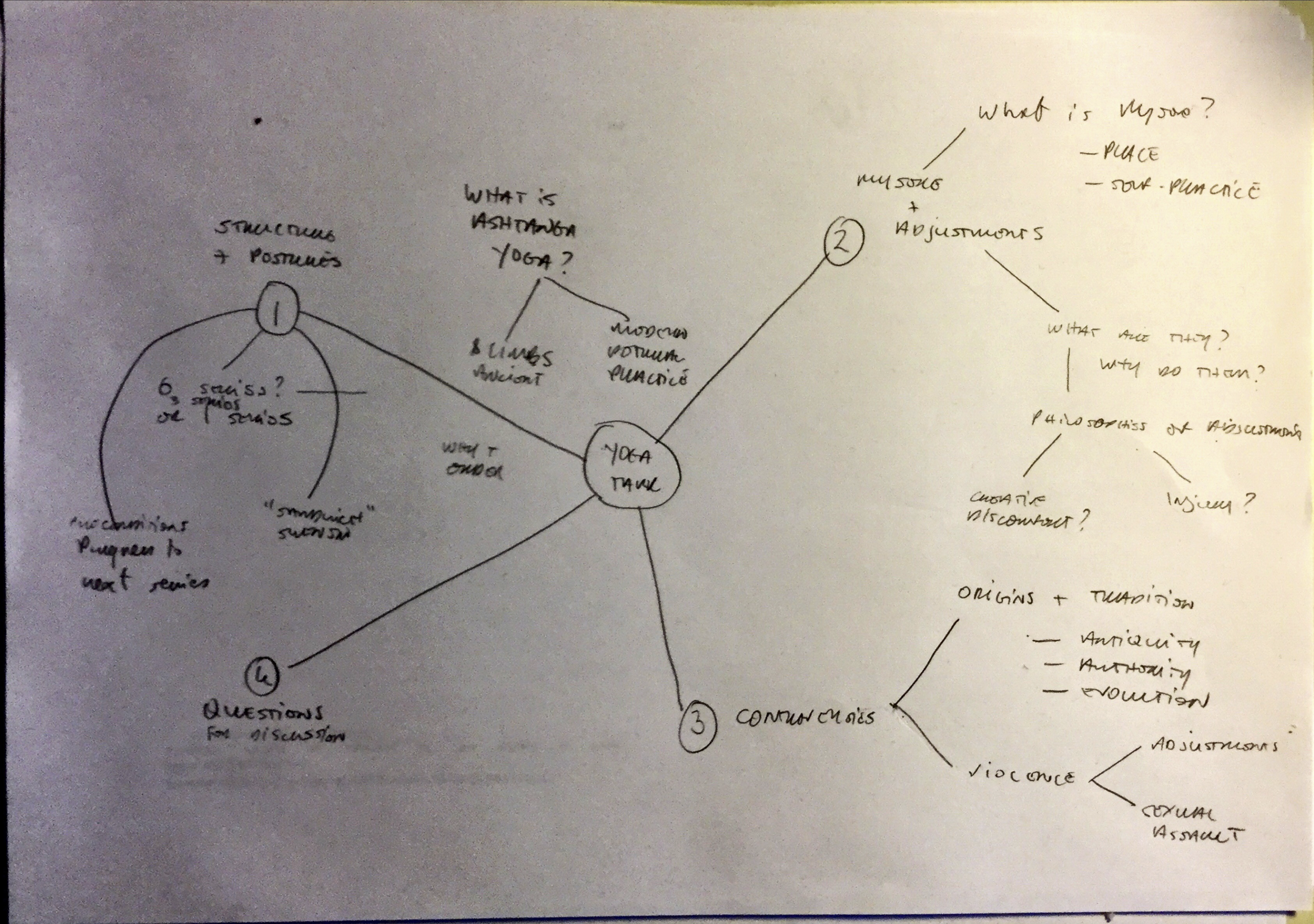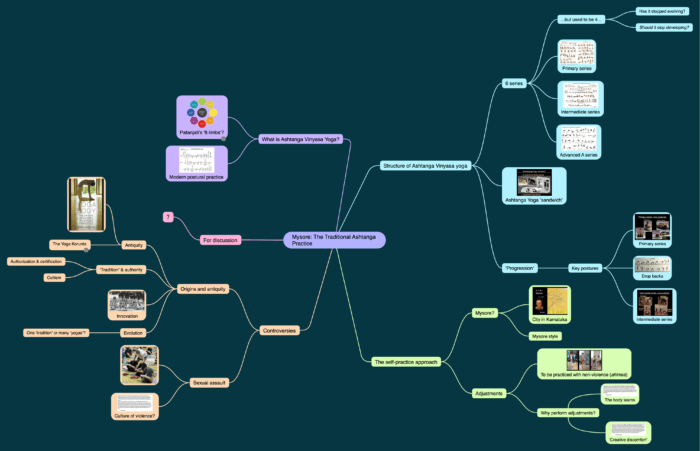Response 16 - Yoga mind map

Dear Marie,
I felt a big sense of responsibility with this task, and have awkwardly ‘over-responded’ as a result. Yes, I have again made a bad film. Yes, the next next time, I promise I won’t.
Why the sense of responsibility? Well, the task asked me to prepare material for the Ashtanga yoga workshop we will co-teach in Aarhus in January 2019. The Ashtanga practice is very important to me, as it is to you, and it has accompanied my life for nearly two decades. But I have always felt ambivalent about it: it can bring out an unpleasantly competitive aspect in practitioners; it has a hierarchical authority structure that has generated cult behaviours; and it facilitates violence. This violence is of three kinds:
- The regular sexual assault suffered by the female students of Pattabhi Jois, the codifier of the Ashtanga system, was public but unspoken knowledge among the practice community—only in the last few years has it been written about, powerfully and movingly by victims and others.
- ‘Adjustments’—that is, hands-on help with posture—are a core part of Ashtanga teaching, but have sometimes been performed insensitively by teachers so that students have ended up injured. There almost been a culture in Ashtanga of students boasting of being ‘broken’.
- The structure of Ashtanga, whereby one is ‘awarded’ the next (more difficult) posture or series of postures, means that students often over-try or over-train, so that they damage themselves. The design of the series suggests that you are a ‘better’ practitioner the ‘further along’ you are.
In my Aarhus presentation, I will introduce the practice and describe its form and benefits (as I see them). The purpose of the presentation is to attract and inform students. But I also need to point to the problems, and to try to encourage a conversation about how we can forge a non-hierarchical and a feminist yoga.
The task asks me to make a mind map showing the themes and elements of the January presentation, which will be based on a presentation I did some years ago at the Yoga Space Leeds and also in Camyoga. When I went back to this material I found I was uncomfortable with the instructional tone, but in thinking about the Aarhus presentation I have struggled to find a persuasive way to combine the descriptive with the critical content. Apart from the essential material on sexual assault and other violences, I want to deal with the question of the authenticity and antiquity of the Ashtanga tradition—aspects unhelpfully shrouded in myth—but I want to do so without adopting the Orientalist perspective of a Westerner pronouncing the ‘truth’ about an Indian practice.
Anyway, I made the map. The initial drawing is reproduced at the top of this post, while the app version (made with the excellent iThoughtsX software) is here—click to enlarge in a separate window.
The mindmapping app has a presentation facility, and I thought I would use this with screencapture to generate a film we could maybe use as a trailer for the January workshop. I felt, though, that I would need to add some illustrative material, and ended up making a more standard short film using diagrams, photos, text and audiovisual material in addition to the mindmap elements (materials are drawn from a wide variety of sources and listed below). The clumsy film encapsulates my own ambivalence: it tries to combine description with criticism while raising points for discussion. I hesitated before including shocking images of Pattabhi Jois assaulting female students, but felt I had to, in order to illustrate the stakes of the discussion. I hoped to avoid voiceover, but the film needed it; I got you to record some of it—thanks! I don’t expect you will use the film as a trailer for the workshop, at least in this rushed first version. But I’m happy to revise (after the holidays!).
Film Credits
Audiovisual
- Mysore practice taught by Marie Hallager Andersen in Leeds 2012 (film by Alan O’Leary)
- Footage from the Gokulam shala (now known as the K. Pattabhi Jois Ashtanga Yoga Research Institute) from two films:
- Enlighten Up!(Kate Churchill, 2008). The talking head is Nick Rosen.
- Guru(Robert Wilkins, 2006)
- Footage from the old shala in Lakshmipuram from a video entitled ‘Mysore Yoga Shala’ uploaded to YouTube by Tom Sewell at https://youtu.be/TrboXf3TQpI
- Footage of Pattabhi Jois sexually assaulting a student during a class, probably in the 1990s, is from a video entitled ‘Pattabhi Jois Ashtanga Yoga Adjustments’ which appears and disappears on YouTube. As of 23 December 2018, it can be seen here: https://youtu.be/2LQCZq9_oYM.
Images
- Charts of the Ashtanga series: Primary – Not sure who the practitioner is in this sheet, which exists in versions credited to Ashtanga Yoga Italia (the version reproduced here) and Ashtanga Yoga Canada. Intermediate – Ryan Spielman, based in London. See http://www.trueryan.com. Advanced A – This is only glimpsed in the film, but the diagram is in French with drawings of a female practitioner. Most instruction sheets, as in the previous two, feature male practitioners.
- Famous photograph of Krishnamacharya (standing on the kid in Kapotasana) with his students, supposedly in the courtyard of the Mysore palace where he had his gym.
- Images of Richard Freeman performing core postures from his DVD ‘Ashtanga Yoga: The Primary series’ (Sounds True, 2002)
- Back bending sequence from Matthew Sweeney, Ashtanga Yoga As It Is (Yoga Temple, 2006)
- Pictures of Joey Miles adjusting Utthita Hasta Padgangusthasa, Paschimottanasana and handstand from his Mysore class at the Yoga Space in Leeds (photos by me from 2010 or 2011)
- Image of Pattabhi Jois groping two female students from a photograph probably taken during one of his world tours in the 2000s
Texts
- The concept of the “Ashtanga Yoga sandwich’ comes from David Swenson. I think he describes it in his Ashtanga Yoga: The Practice Manual, 2nd edn (Ashtanga Yoga Productions, 2007).
- Quotes from Gregor Maehle from his book Ashtanga Yoga: The Intermediate Series (2009), p. 60, and from a blog post entitled ‘My Initial Response to Karen Rain’s Interview About Sexual Abuse’ (May 2018), available at https://chintamaniyoga.com/teaching/my-initial-response-to-karen-rains-interview-about-sexual-abuse/
- Quote from Brian Cooper from his The Art of Adjusting, 1stedn. (2006), p. 10
- Mark Singleton, Yoga Body(Oxford university Press, 2010)
- Quote from Matthew Remski from his article ‘Yoga's Culture of Sexual Abuse: Nine Women Tell Their Stories’ (April 2018), available at https://thewalrus.ca/yogas-culture-of-sexual-abuse-nine-women-tell-their-stories/. See also his interview with Karen Rain at http://matthewremski.com/wordpress/karen-rain-speaks-about-pattabhi-jois-and-recovering-from-sexual-and-spiritual-abuse-video-interview/.

